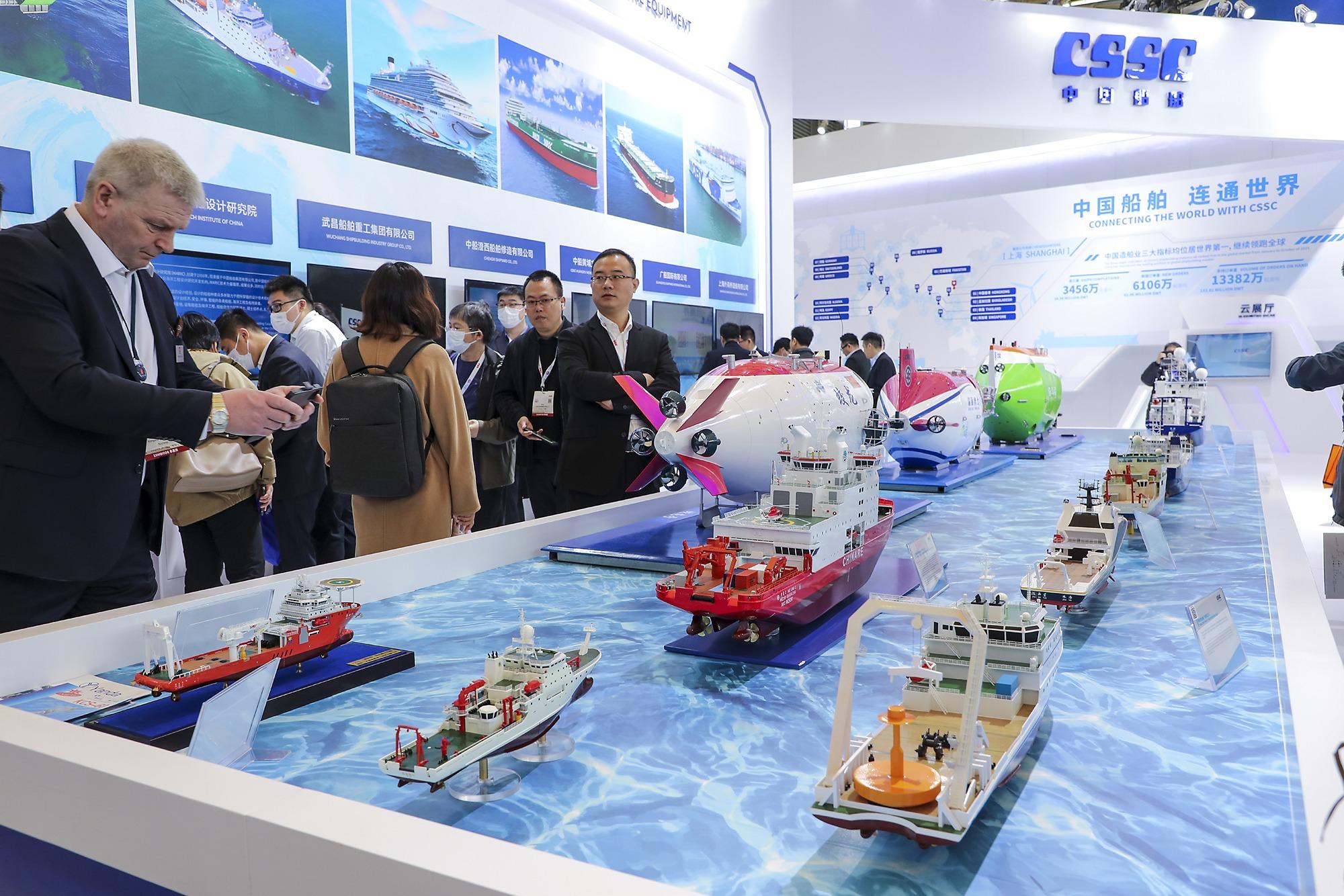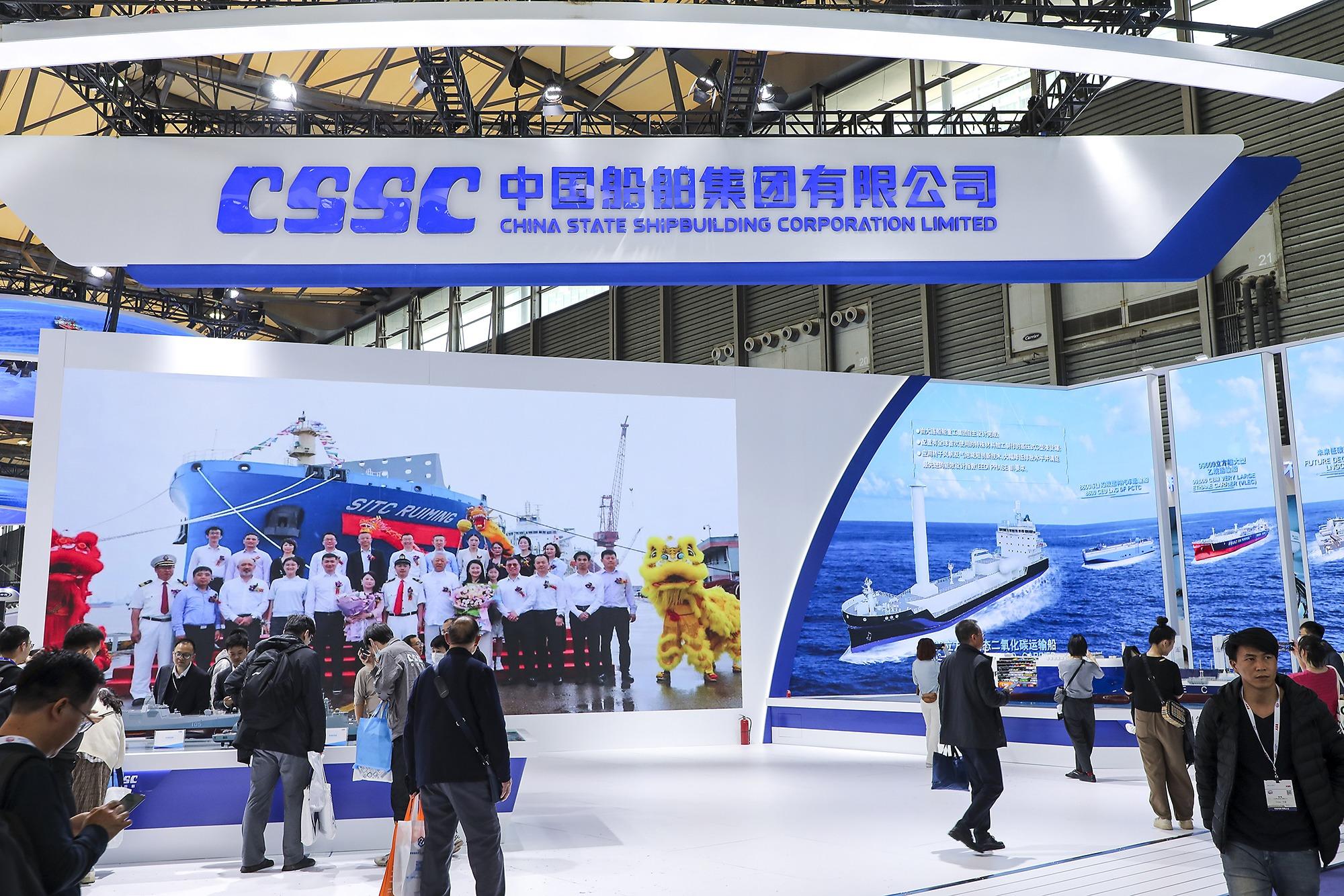Fresh regulations to entail upgrades in operational fleets globally, lifting demand
 Visitors check out shipping vessel models during the Marintec China 2023 expo in Shanghai in December. (PROVIDED TO CHINA DAILY)
Visitors check out shipping vessel models during the Marintec China 2023 expo in Shanghai in December. (PROVIDED TO CHINA DAILY)
China's shipbuilding industry is actively seizing new opportunities as the sector globally transitions into a phase of low-carbon and green development, industry experts said.
The International Maritime Organization unveiled a revised greenhouse gas emissions strategy, or IMO 2050 net-zero target, in July 2023, wherein all members agreed to reduce emissions from 2008 levels to net zero by or around 2050.
"The global environmental regulations cover both vessels built in the future as well as retrofitted ships in service, to better align with the new requirements," said Zhou Dequan, director of the Shanghai International Shipping Institute's domestic shipping research office.
"A huge number of ship fleets in operation will have to upgrade and renovate in accordance with the new rules, which will generate demand in the coming years," said Zhu Jianzhang, vice-president of the Marine Design and Research Institute of China.
According to Zhu, the implementation timeline will cover almost all vessel types, requiring improvements in terms of performance, carbon emission and artificial intelligence.
Marintec China 2023, the world's largest and most influential event of its kind in 2023 held in Shanghai in December, was widely regarded as a stage to showcase shipbuilders' latest products, cutting-edge technologies and trends.
More than 2,000 enterprises from over 30 countries and regions attended the biennial event, with 42 percent coming from overseas, making it the largest in its history.
"Low-carbon or even zero-carbon has become the future development trend of the shipbuilding industry, and a large number of low-carbon or zero-carbon emission technologies and products from Chinese shipbuilders were displayed at the exhibition, drawing a picture of future development of the maritime industry," said Xing Wenhua, chairman of the Shanghai Society of Naval Architects and Marine Engineers and chairman of the Chinese organizing committee of Marintec China.
Shanghai-based Jiangnan Shipyard (Group) Co Ltd, a unit of China State Shipbuilding Corp, officially released its design for the world's largest nuclear-powered container ship with a capacity of 24,000 TEUs (twenty-foot equivalent units) and received in-principle approval from certification agency Det Norske Veritas at the Marintec China on Dec 5.
Tapping into the zero-carbon emission trend, the vessel — equipped with the latest nuclear solution — is the latest attempt by Jiangnan Shipyard to deploy clean energy to realize truly zero emissions throughout the complete operational cycle of the ship, according to the Shanghai-based shipbuilder.
"Driven by low-carbon requirements, Chinese shipbuilders have in the past few years spearheaded a series of design, research and development initiatives for powering ships with various clean energy sources," said Zhu of the Marine Design and Research Institute of China.
"Four years ago, vessels built by us were powered by liquefied natural gas, but now we have developed a variety of low-carbon emission energy sources to serve as fuel for ships made in China," Zhu said.
 People gather at the booth of China State Shipbuilding Corp during the recent Marintec China expo in Shanghai. (PROVIDED TO CHINA DAILY)
People gather at the booth of China State Shipbuilding Corp during the recent Marintec China expo in Shanghai. (PROVIDED TO CHINA DAILY)
Zhu was referring to the world's first 23,000 TEU liquefied natural gas-powered container ship delivered to French shipping and logistics group CMA CGM Group by Hudong-Zhonghua in Shanghai in September 2020, which marked a milestone by Chinese shipbuilders in research and development, design and building world-class vessels.
Hudong-Zhonghua has continued to innovate, and improve R&D in powering container ships with low-carbon energy sources, including LNG, liquid ammonia and methanol, by tapping into the specific requirements of ship owners.
The Shanghai-based shipbuilder launched a design for a 16,000-TEU container ship powered by ammonia at Marintec China.
The ship, characterized by light structural weight, large cargo-carrying capacity and high comprehensive performance, is expected to offer the industry a new choice of green, environmentally friendly, safe and reliable vessels.
In addition to the ammonia-powered container ship, Hudong-Zhonghua also showcased an indigenously designed liquefied hydrogen carrier that is capable of carrying 40,000 cubic meters of gas on one trip; the world's currently largest liquefied liquid ammonia carrier with a capacity of 88,000 cu m, as well as a 174,000 cu m LNG carrier equipped with a carbon capture system.
Also at the Marintec China 2023, Shanghai Waigaoqiao Shipbuilding said it had received new orders for six PCTCs (pure car and truck carrier), each with 10,800 parking spaces. It is the world's first very large PCTC order with a capacity of over 10,000 parking spaces, according to the Shanghai-based shipbuilder.
Including the above-mentioned order placed by Canada-based Seaspan Corp, Waigaoqiao Shipbuilding's total PCTC orders on hand amount to 16 vessels.
Designed by the Shanghai Merchant Ship Design and Research Institute, the super large PCTCs will each have 14 car decks, and the multilayer car decks can load various new energy vehicles powered by energy sources such as hydrogen, compressed liquefied natural gas and liquefied petroleum gas.
The construction of six dual-fuel powered PCTCs will help further enhance Waigaoqiao Shipbuilding's market share and international influence, experts said.
Zhou of the Shanghai International Shipping Institute's domestic shipping research office, said China's robust automotive exports over the past few years have driven demand for shipping and manufacturing capacities of PCTCs.
Despite a 17 percent year-on-year growth in automotive transportation capacities to 23.7 million units in 2023, the shortage of car shipping capacity can hardly ease off in the near future, Securities Daily reported, citing an estimate by shipping industry data provider Clarksons.
In the first 11 months of 2023, 4.4 million vehicles were exported, surging 58.4 percent year-on-year, said the China Association of Automobile Manufacturers.
China Merchants Industry Holdings Co Ltd has also tapped into the green trend by releasing an ultra-large intelligent PCTC vessel model with a capacity of 11,000 parking spaces at Marintec China 2023.
The new generation green PCTC ship received design certification from DNV along with a 180,000 cu m LNG carrier model and a 200,000 cu m LNG ship at the event.
Zhu said the net-zero regulations will profoundly affect the development pattern of the world's shipbuilding industry in the next few decades, offering opportunities that the Chinese shipbuilding industry cannot afford to miss.
According to Zhu, the Marine Design and Research Institute of China also exhibited a batch of green, energy-saving and low-carbon ships, including a 20,000 cu m liquefied hydrogen carrier, an ultra-large 102,000 cu m ethane carrier, a 40,000 cu m liquefied carbon dioxide carrier, and an 88,000 cu m liquefied gas carrier.
"There is still room for China's shipbuilding industry to grow, particularly in high-end vessels. The research, development, and construction of these innovative ships will help upgrade talent and techniques, and further raise the standard and quality of Chinese shipbuilding as a whole," Zhou said.


